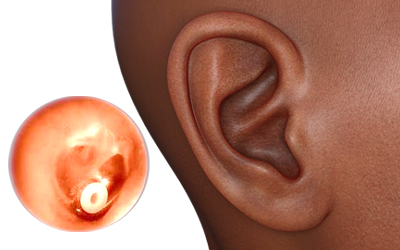Myringotomy
Myringotomy, also called as Ear tube surgery is usually performed to create a hole in the ear drum to allow fluid that is trapped in the middle ear to drain out.

Some facts about Myringotomy:
- The fluid that is drain out during Myringotomy may be blood, pus and/or water.
- Hearing loss caused by chronic fluid build-up can be restored by doing a Myringotomy.
- Myringotomy can be done to prevent delayed speech development caused by hearing loss in children.
- A myringotomy may be done to place tympanostomy tubes which help to equalize pressure.
- Recurring ear infections and the accumulation of fluid behind the ear drum can also be prevented by doing a Myringotomy.
- A myringotomy may be required to help treat an ear infection that is not responding to medical treatment.
- Sample fluid from the middle ear during a myringotomy to examine in the lab for the presence of bacteria or other infections.
- Pain and/or pressure in the ear due to fluid build-up will be alleviated and hearing loss due to fluid build-up will get improve after the procedure.
- Bleeding, Infection, Chronic scarring, Hearing loss, Injury to ear structures other than the ear drum and Need for repeat surgery are some of the risk of Myringotomy.
- Failure of the myringotomy incision in the ear drum may result in frequent drainage.
- Ear tubes are small, hollow cylinders that are inserted into the eardrum of children who have had several middle ear infections, or infections that have resisted treatment during myringotomy.

Preparation for Myringotomy:
- Some blood tests and hearing test will be conducted before the surgery.
- Your doctor may examine the external ear and the ear drum with an instrument called an otoscope.
- A test that measures how well the ear drum responds to changes in pressure called Tympanogram will be conducted before the surgery.
- You will be asked not eat or drink anything for at least eight hours before the procedure
- You may be asked to stop taking some medications such as blood thinners, antiplatelets and nonsteroidal anti-inflammatory medications (NSAIDs), one week before the procedure.
Procedure for Myringotomy:
- Myringotomy is usually performed while the patient is under general anesthesia.
- It can also be done with a local anesthetic in adults.
- A small incision will be made in the eardrum by the surgeon with a scalpel or with a laser during the process.
- A small microscope will be placed in position to give a better view to the doctor.
- Fluid from the middle ear will then be drained or suctioned out.
- A tube will be inserted into the incision in the eardrum by the doctor to allow fluid to drain out of the ear.
- The surgeon may also remove the adenoids which are glands that are located above the roof of the mouth and behind the nose in some cases.
- Removing the adenoids may prevent the need for future ear tube surgeries as adenoids are part of the immune system and help protect the body from viruses and bacteria.
- Usually, the surgery is outpatient surgery and takes less than 15 to 20 minutes. The patient can go home the same day.
- No stitches will be used to close the incision as the incision will heal itself.
- Pain during surgery can be prevented by using anesthesia.
Recovery from Myringotomy:
- You may experience minor pain after surgery, for which you can take pain medication prescribed by your doctor.
- Nonprescription pain reliever can also be taken to manage this discomfort.
- Lidocaine ear drops may be given to decrease pain.
- You may feel popping, pulsation, clicking, or minor pain when burping, chewing, or yawning until the ear heals around the tubes, if ear tubes are inserted.
- Change the cotton regularly, if it was placed in the ear canal to absorb postsurgical drainage.
- Drainage should get stop or reduce to a minimal amount within 2 to 3 days
- Ear drops, should be used as directed, if given.
- Monitor for drainage, if water gets in the ear after surgery. Use ear drops if drainage begins or call your doctor if drainage continues for three days.
- Medications should be taken as prescribed by your doctor
- Ear plugs should be used as prescribed by your doctor while swimming or bathing, and underwater swimming and diving should be avoided unless instructed otherwise.
- Do not place anything other than ear drops, cotton or ear plugs into the ear, unless instructed otherwise by your doctor.
- Complete healing without complications may take four weeks.
- Usually, the eardrum closes around the ear tube to keep it in place and prevent it from falling out early
- Ear tubes should fall out within 6 to 12 months if they were inserted.
- Surgery to remove the ear tubes may be necessary in some cases.
- Contact your doctor if you have signs of infection, including fever and chills; redness, swelling, increasing pain, excessive bleeding or discharge from the ear; pain that you cannot control with the medications you have been given; drainage from ear continues for more than four days after surgery; decreased hearing; cough, shortness of breath, chest pain or severe nausea or vomiting or any other concern.
